They had all watched him die, in a foreign land
A warning to others from the High Command.
Forfeits medals (sentenced to death). Sentence Duly carried out.
This grim notation is in the UK, WWI Service Medal and Award Rolls, 1914-1920 entry for Private 7429 Herbert Morris of the 6th Battalion of the British West Indies Regiment.
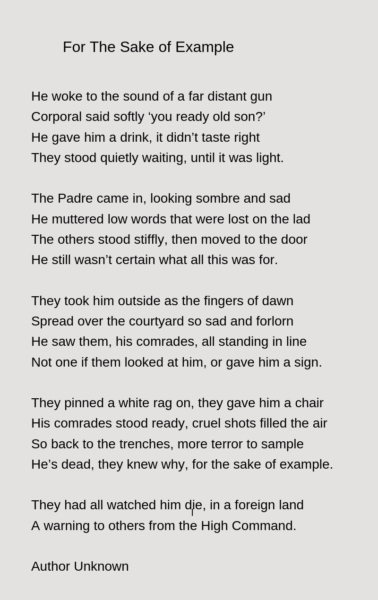
Amid all the cruelty, carnage and waste of the Western Front some stories still have the capacity to shock, and enrage. The death of Herbert Morris is one such story.
On the morning of September 20th 1917, Private Morris was led into the inner courtyard of the town hall of Poperigne in the Ypres Salient. There – by the rear wall of a coal shed with walls covered with sandbags to prevent ricochets – he was blindfolded, tied to a post and shot to death by a firing squad.
The place is now a sombre tourist destination on the Flanders battlefield circuit. There’s an execution post and the basement rooms that were used as holding cells for those awaiting trial and the condemned. On the walls is the graffiti they carved into the walls.
Private Morris was the son of William and Ophelia Morris of Riversdale in the parish of St.Catherine below the Blue Mountains of Jamaica, thirty miles from Kingston. When the war began, many in the West Indies responded with a desire to serve. Some made their way to Britain to enlist by paying their own passage or as stowaways. Others raised funds and made charitable donations to support the war effort. Others argued that this was a white man’s war, that they should stay out of it, and questioned whether they should get involved.
Black participation in the military as front-line soldiers – particularly on the Western Front – was a matter of considerable debate at the War Office. Casualties in the British Army were high in the first year of the war, and – while the High Command were initially opposed to the idea of using non-white troops – it agreed to the formation of a regiment after King George V intervened in the dispute. The British West Indies Regiment was formed in October 1915 and started recruiting.
Herbert Morris enlisted during a recruitment drive in December 1916. We don’t know why he enlisted nor what his parents felt about it.
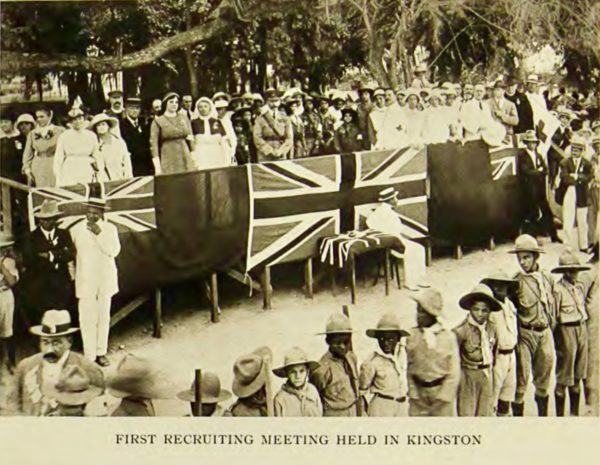
Perhaps he was caught up in the excitement of the moment or responded to pressure from his family and community. Perhaps he wanted to do his bit for king and empire out of a sense of duty, service, and loyalty to the motherland. Perhaps he sought a chance to see the world and prove himself. Perhaps he had few choices and avenues open to him and the army and service in a foreign war offered adventure and opportunity.
Come Forward to Fight: Put Yourself Right with your King and Your Conscience
Patriotic recruitment posters like these appeared in The Gleaner in Kingston. They are worth reading to see the kinds of appeals and promises they make. The appeals are to patriotism, loyalty to King, Empire, and manhood. The promise is to be able to fight – to be a part of a life and death struggle against an Imperial foe – to play a part in history.
They were repeatedly told by recruiters of the ‘very distinct advantages’ of enlisting. Among these were the prospects of gaining medals, glory, discipline, exercise and free land at the cessation of hostilities’ (Glenford Howe’:‘Race, War and Nationalism: A Social History of West Indians in the First World War’ 2002.)
These were promises that were not kept
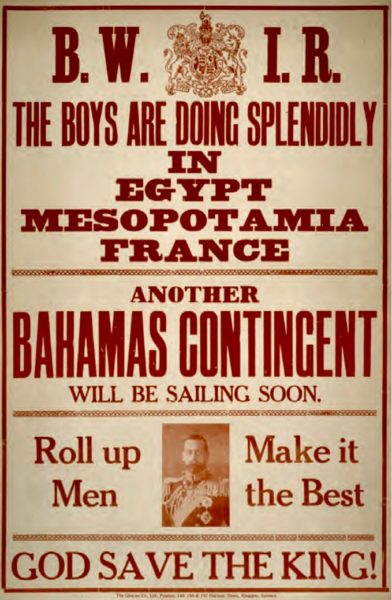
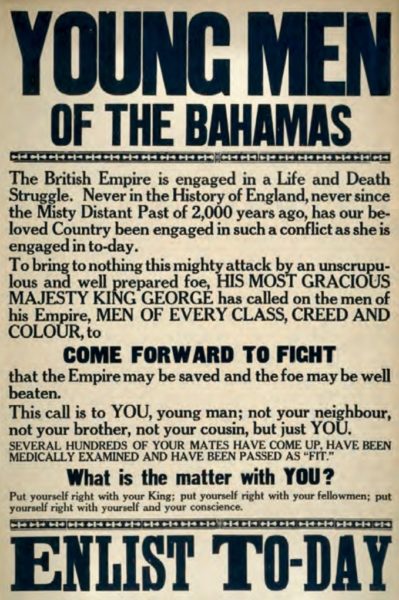
Herbert Morris was a part of the the fifth contingent of West Indian recruits. He left Jamaica on March 30th 1917 on the HMT Briton, escorted by a British warship. There were 30 white officers and 1656 men most of whom were between 19 and 25 years of age but a few were as young as 17 and as old as 48. They were all volunteers.
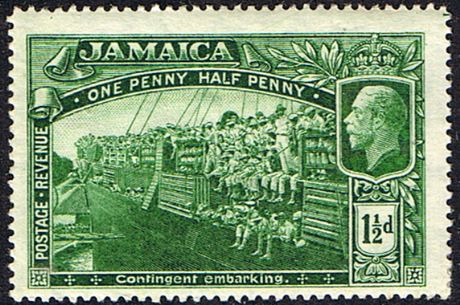
The occupations of the majority were given as laborers, cultivators, carpenters and cabinet makers, clerks, smiths and mechanics, boot and shoe makers, tailors, coachmen and grooms, masons and builders, and printers. They became imperial troops on the date of embarkation and the contingent became the 6th battalion BWIR. They were under the command of Captain R.E.Willis who – a year later, as Lt. Col. Willis with a reputation as a particularly brutal officer – was to play a notorious role in the mutiny at Taranto.
The ship called at St.Lucia and Martinique. A serious outbreak of measles and broncho-pneumonia caused many men to be put ashore. Twelve men recovered and were picked up when the 8th battalion sailed in July 1917. Eleven died and were buried at Choc Bay War Cemetery on St. Lucia..
At Martinque, the escort was changed and a French warship accompanied them to France. They arrived at Brest on April 17th – the first batch of troops to land in France directly from the West Indies. One officer and 10 other ranks died during the voyage or shortly after arrival in France. At the end of April the whole battalion was put into isolation owing to an outbreak of mumps.
They received a warm welcome from the local population as they marched to the entraining point for the line at Neuville-au-Cornet, in St. Pol, west of Arras. From there they proceeded to the Ypres salient and were attached to the Fifth Army.
The 6th battalion was not deployed as front line combat troops but as laborers responsible for digging trenches, latrines, moving ammunition and generally supporting troops on the frontline.Their main duties were handling ammunition at dumps, railheads and batteries where they often came under heavy shelling. They had to abandon their camp soon after arrival when the wood where it was located came under heavy fire. Detachments offloaded and delivered ammunition to batteries at Vlamertinge, Elverdingue, Burnt Farm, Joeffre Farm, Essex Farm and other locations along the front. They were often exposed to shellfire and bullets and suffered casualties but had no capacity to retaliate.
They arrived as the preparations for the Battle of Third Ypres (Passchendaele) were ramping up. They served a battery of 80 pound guns at Essex Farm near Poperinge in the Ypres salient which was part of the largest artillery formation yet seen. In the 15 day barrage preceding the main allied attack that began on July 31st, 3,000 British guns fired over 4 million shells – four times the number fired prior to the Battle of the Somme. The Germans responded in kind and the 6th battalion suffered many casualties.
As the bombardment began on July 16th, Pte. Morris left his detachment and made his way to Boulogne where he was found the following day. For this offense he was he was given 14 days Field Punishment Number One.
F.P.No.1 was introduced after flogging was abolished and consisted of a convicted man being restrained in fetters or handcuffs and tied to a fixed object such as a gun wheel or fence post for up to two hours a day.
A War Office advisory of January 1917 gave the following guidelines:
…the soldier must be attached so as to be standing firmly on his feet, which if tied, must not be more than twelve inches apart, and it must be possible for him to move each foot at least three inches. If he is tied round the body there must be no restriction of his breathing. If his arms or wrists are tied, there must be six inches of play between them and the fixed object. His arms must hang either by the side of his body or behind his back.
… irons should be used when available, but straps or ropes may be used in lieu of them when necessary. Any straps or ropes used for this purpose must be of sufficient width that they inflict no bodily harm, and leave no permanent mark on the offender.
In addition to this humiliation, Morris would also have lost his pay.
Three weeks later, on the 20th of August Morris went AWOL again.
At his trial for desertion on September 7th, the court was told that Morris had been one of a detachment of 60 men who were on their way from their camp at Poperinge to work with the artillery at Burnt Farm, Essex Farm. He was seen boarding the lorry but he was missing when they arrived. He appeared at the St.Martin’s Rest camp in Boulogne the next day saying he had been sent there by mistake and was on his way to Le Havre. He had no leave warrant and was arrested.
The charge: When on active service deserting His Majesty’s Services, in that he, in the Field on the 20th of August 1917, when warned for duty, in the neighbourhood of the front line absented himself from his detachment until apprehended by the Military Police at Boulogne on the 21st of August 1917.
Morris had no “prisoner’s friend” to speak on his half but he did make a statement:
I am troubled with my head. I cannot stand the sound of the guns. I reported to the Doctor and he gave me no medicine or anything. It was on Sunday 19.8.17 that I saw the Doctor. He gave me no satisfaction.
Morris does not seem to have been medically examined before the trial and the doctor was not called as a witness or provide evidence.
Two of his officers did give character references. Lt. Andrews told the court: “The accused has never given me any trouble. He is well behaved. I have known the accused for six months. His intelligence is higher than the ordinary man in my platoon.” Captain Russell said: “The accused has never given me any trouble and is a willing worker.”
The court record does not mention Morris’s age and he did not raise it as a plea for mitigation. Even if the army had checked his records they would only have had the age he named on enlistment where he presumably lied.
The court pronounced Morris guilty and sentenced him to be executed. The sentence was confirmed by Field-Marshall Haig.
Morris was paraded in front of the battalion as an example. He dictated a letter for his parents to the battalion padre, Alfred Horner. And at 6.10 am September 20th he was taken out into the courtyard and shot by a firing squad that comprised 7 West Indians and 3 white soldiers.
Private Herbert Morris was 17 years of age.
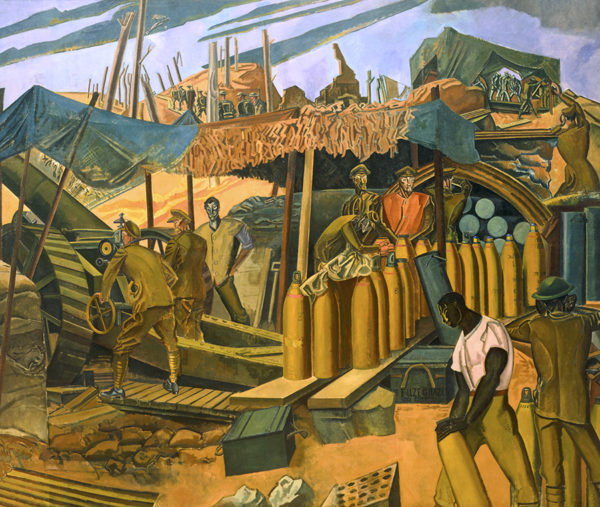
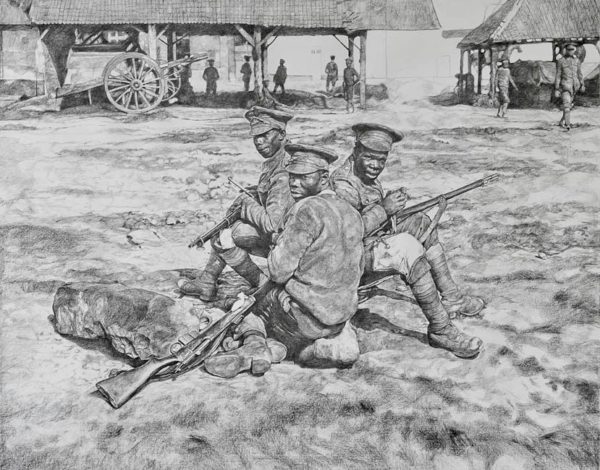

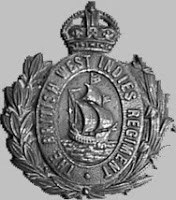 Herbert Morris is buried Poperinghe New Military Cemetery where he lies with 680 others, 16 of whom who were also ‘shot at dawn’. The headstone does not reveal the circumstances behind his death, reflecting the
Herbert Morris is buried Poperinghe New Military Cemetery where he lies with 680 others, 16 of whom who were also ‘shot at dawn’. The headstone does not reveal the circumstances behind his death, reflecting the
Commonwealth War Graves Commission’s principle of equality amongst the dead.
On the 8th November 2006 – 89 years after his execution – he was pardoned along with 306 other soldiers executed for desertion and other offenses.
Of the over 15,000 West Indian men who volunteered for the BWIR, two-thirds from Jamaica, 185 were killed and 1,071 died of illness as a result of the war. Many more were casualties.
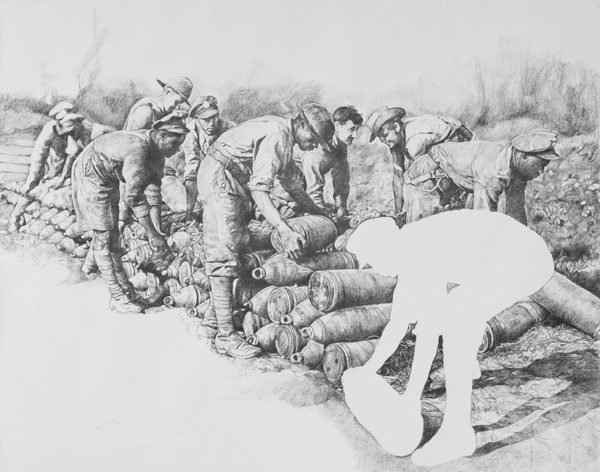
Sources include:
- Glenford Howe’:‘Race, War and Nationalism: A Social History of West Indians in the First World War’ 2002.)
- The Great War in Post-Memory Literature and Film ed. by Löschnigg, Martin Sokolowska-Paryz, Marzena
- Race, Empire and First World War Writing edited by Santanu Das
- Stories of Omission: Conflict and the experience of Black soldiers
- Imperial War Museum
- Jamaica’s Part in the Great War
- Black Poppies: Britain’s Black Community and the Great War by Stephen Bourne Commonwealth War Craves Commission
- Richard Smith – Memories of British West Indian Service in the First World War.
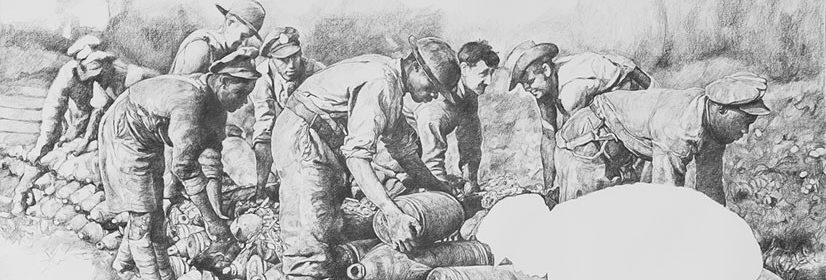


Thank you so much for this post.
Gwen.
All good examples of scholarship on a topic which draws unexpectedly piqued interest. Capital punishment is a novel point of departure for outsiders looking at armies especially those of past eras. For those with little or no military experience of their own, they fall into a trap of inferring modern-day mores and values for military societies which evolved quickly and often with little documentary evidence.
Punishments always seem to fascinate onlookers. There is a current case against a Canadian cadet instructor cadre junior officer for incitement to mutiny (https://toronto.ctvnews.ca/military-officer-facing-mutiny-charge-after-anti-vaccine-speech-in-toronto-1.5441954) by discouraging other soldiers to participate in vaccine distribution. The maximum punishment is imprisonment for life or to less. Execution having been removed from the Canadian table of punishments quite recently – decades after it was banned for civil offences. Why was it still there? Bureaucratic inertia to change complex documents. The old military standby excuse of, ‘well someone thought it was a good idea then so it might not be wise to remove it without good reason’. And the go-to norm of, military discipline is tough because the soldiers need to be treated firmly.
I dislike being hectored about the micro-granularity of history by those who misread my previous remarks. It was clear I emphasized the very large scale issue of fatigue duties, underage enrollment, and punishment like AWOL. I believe such a minute study of personalities undermines objectivity on the extremely large currents of very big issues, notably the Great War. In the case of the Private, little is known about him, but there are others happy to weave an airtight lifestory around him. One which supports their interpretations.
I would draw attention to the numbers of executions in 1915 as evidence of an army which is learning how to behave. The pre-war professional British army held the line as well as it could in the early battles. However, it was overwhelmed by losses and largely replaced by units (soldiers, NCOs and officers) which lacked the thorough knowledge of the rules of the game. Inevitably, soldiers and officers overstepped their boundaries. A charge which might be heard by a well-trained field grade officer in 1914 would be heard by a rapidly promoted former junior officer who could read the King’s Orders, but might lack the wisdom how to actually lead men who were civilians not long ago. The same way, offenders didn’t realize the severity of their actions on unit cohesion and battlefield momentum.
The consolation is every battalion had to do exactly the same kind of work the Private was doing. And then go forward to get shot at in the trenches closer to the enemy. The Private’s unit did not share quite the same risk.
Underage soldiers have been a feature of warfare forever. Nothing unusual about the Private’s enlistment, including that he lied about his age.
He went AWOL and was punished. That sentence was swift, brutal and simple. Going AWOL again so soon afterwards was inexcusable and the sentence may have been harsh, but fully within the table of punishments to maintain discipline. (Here’s a little secret, armies don’t like it when someone breaks the rules that apply to everyone.)
In the early part, recruiting for First War service was framed as the voluntary patriotic duty of white Christian British manhood; women, overage men, infirm, essential workers, short Welshmen, etc. need not apply. That chauvinism changed as the casualties mounted. Your story about the Private perfectly illustrates the impersonal momentum of feeding able-bodied men into a very compelling and destructive system.
I rather think you have missed the point.
Likewise, you seem to have missed my points and insist there is only your interpretation allowed for the story.
We’ll just have to agree that we have different approaches to historical interpretation.
Signed, BA (Hist) and military veteran
Hi Terry – My post is rather short on interpretation (It does contain passing reference to my personal reaction. A reaction I hope would be shared by all even in the face of the fact that such events were all too commonplace.)
What it does contain is a scrupulous gathering of all the facts publicly available about Pvt. Herbert Morris – everything I could find about his life and his death. That research is presented without commentary. The facts – such as are available – are the facts. Nothing is invented or re-created. And those facts include the racism of the High Command that was, of course, consistent with the thinking of the era. For the young men of the West Indies, that racism – when it came to deployment – was a betrayal of the promises made when they enlisted. The discrimination they faced was a long slow burn for many who returned home. I wrote more about this here.
I am very familiar with the routines of daily life on the Western Front (so much as anyone can be this far out). And I understand your point about the hard physical labour of WW1 soldiering. Are you familiar with the Regimental Unit Diaries at the National Archive? Essential resource for anyone seeking a sense of what it was like back there, then. And all in the language of military officialdom. They are currently free to download.
No one alive served on the Western Front in any army. And no one alive served in the BWIR. We have to rely on available resources.
You are correct in commenting that one story cannot encompass the whole narrative of a global catastrophe like WW1. How could it? However, our collective historical memory of that war is made up of all of the stories we have heard, have read, and have researched.
Herbert Morris is one small cog in that giant wheel. Just as your service was yet another cog in a later wheel of history. I am curious now about any WW1 stories in your family. What were they? And how did you and your family interpret them?
My family’s Great War stories you ask?
My paternal grandfather was too young to volunteer or be drafted, and was always needed on the farm. The family history doesn’t mention any others in either his extended family or on great grandmother’s side serving in that war.
My father’s mother’s extended family had sons and sons-in-law served in all three services in WW2 and in essential industry. By 1939 the grandfather who was too young for the Great War had built a successful trucking company that hired drivers, helpers and mechanics where ever they could due to labour shortages.
My maternal grandfather was an essential industry worker in UK. Apparently to explain his civilian status, he wore a lapel badge to show he was willing but not called up. Subsequently, he entered divinity school and emigrated to Canada. He was overage and had chronic conditions which precluded service in WW2. One of my mother’s uncles on her mother’s side was a pre-war Canadian air force officer with a ridiculously low service number.
And, between myself, my brothers and our father, we have about 80 years of military service, in three services and Canadian Coast Guard, in the Reserves and Regular Force. I deployed to the Gulf, Bosnia and Afghanistan. Amongst ourselves we have three history degrees, a commerce degree, and two economics degrees, and various college and technology diplomas. Not to mention successive trade and rank courses to advance in our respective careers. Parade square cred’? I think we’ve got some.
That’s a whole lot of service and learning. Thank you for sharing that.
But – if a family had even more (or less) would it make their stories any more (or less) valid? IMO – no.
For me, WW1 had a far more direct and personal impact. As indeed did WW2. Does that make my words more or less important, valuable, true? No. (It’s not a competition.) But it does help explain my sustained interest and my research.
If it is any consolation, the Front was labourious and difficult for all soldiers. All battalions were continually ordered to provide ‘fatigues’ for digging, carrying, filling or draining, and building. While the work was essential for the trench systems to be functional, the work was numbing and dangerous for all soldiers.
What you say is true in terms of the work of infantry on the Western Front. However, I don’t understand your point here in terms of the role of the BWIR and the story of Pvt. Herbert Morris.
How is that general practice any kind of “consolation” for racial discrimination and the inexcusable treatment of a minor?
Terry – For daily life of soldiers on the Western Front you might find this short article by Paul Cornish helpful: https://www.bl.uk/world-war-one/articles/the-daily-life-of-soldiers
Hard physical labour was included part of routine for British troops that rotated between front line service and so-called “rest”. Racial discrimination was separate issue and very interesting from historical point of view. It is tangled up in history of colonialism and development of race theories and white supremacy that developed as a means to justify racist attitudes and behaviours.
You might also be interested in detailed analysis of British Army executions in First World War. I don’t think it provides the consolation you seek but the statistics by division and the analysis might help you. They are of course most instructive and interesting:
“Discipline in the BEF: An analysis of executions in British Divisions 1914-1918” https://www.westernfrontassociation.com/world-war-i-articles/discipline-in-the-bef-an-analysis-of-executions-in-british-divisions-1914-1918/
And if you want the names of those executed, see here:
Shocking though it is to consider, Private Morris was not only teenager shot for desertion or “cowardice” : https://www.privatepeaceful.net/shot-at-dawn
For serious account of Race, Racism and British Military strategy this from our good British Library is place to begin: https://www.bl.uk/world-war-one/articles/race-racism-and-military-strategy
“Race and racism were important aspects of World War One for two reasons. First, ideas about race had developed over the course of the 19th century to make the concept one of the most prominent preoccupations of modern Europeans. Second, several of the major belligerents at war between 1914 and 1918 possessed large colonial empires, where white Europeans ruled over Africans, Asians, and Pacific Islanders. These two factors came together because a large part of the justification for the possession of colonial territories was the supposed right of superior whites to rule over allegedly inferior non-whites. This in turn led several European combatant nations to make use of their colonial resources, both materials and men, to wage war. Thus, while purely military and political considerations often shaped strategy during the war,…”
For further research try our suggestions at the end of Professor Richard Fogarty’s introduction.
Race was determining factor in where and how non-white Colonial troops were deployed: “The British had regularly used colonial troops for imperial defence, but not in Europe or against other white races. Indian troops were not allowed to fight in the Boer War in South Africa (1899 – 1902). If a ‘coloured’ man were trained to raise arms against another European, what guarantee was there, so the racial thinking went, that he would not one day attack his own white master? However, after heavy casualties were suffered by the British Expeditionary Force in August 1914, two Indian divisions were diverted to France. Among the colonial non-white troops of the British empire, only Indians were allowed to fight in Europe. This was predominantly due to racial categorisation in British military policy.” – https://www.bl.uk/world-war-one/articles/colonial-troops
So the more one learns is improvement – more interesting and tangled. When you seek information and analysis you don’t find much consolation but you sometimes gather understanding. Here is example: Hundreds of thousands of Indian troops were in service of British in the course of the war. However, most of those on the Western Front were withdrawn in 1915 and deployed in other (non-European) theatres. Thoughful historian asks: Wonder why. Now let’s get facts.
Thank you for all the resources Sunil.
Sounds like he was suffering from shell shock. Today would be termed PTSD. Was such a gruesome war. No way should the long time Jamaican residents of Britain be being sent back now. Thankyou for bringing this story to light.
Runningonempty´s last blog post ..First Day of Widowhood.
Without a doubt. Crimes against humanity on an industrial scale.
A child. Just a child hurled into the middle of a chaos of meaningless death and destruction.
“In peace, sons bury their fathers; in war, fathers bury their sons.” –Herodotus
“The only war where the men knew what they were fighting for was the Trojan War: it was fought over a woman.” –William Lyon Phelps
“If any question why we died,
Tell them, because our fathers lied.”
Kipling, Epitaphs of War
“Some things never change.” –mistermuse (and others wiser than I) re Kipling quote
What a terrible and disturbing story.
For sure. All of the stories of wartime executions for desertion are disturbing. And those of teenagers even more so. And the systemic and routine daily racism that the black soldiers of the BWIR would have endured is unimaginable. Thank you for reading and commenting.